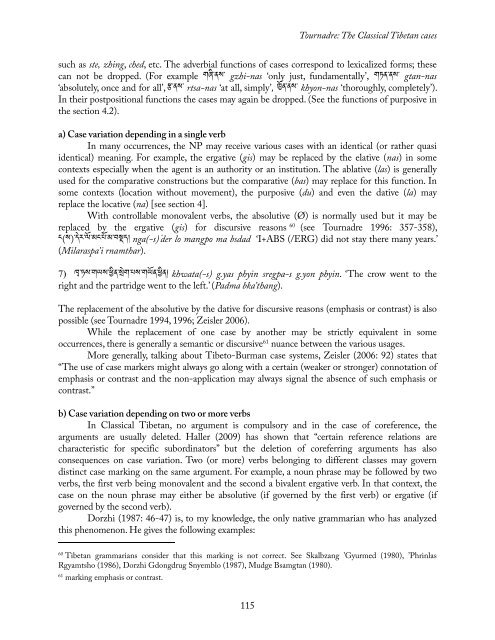The Classical Tibetan cases and their transcategoriality
The Classical Tibetan cases and their transcategoriality
The Classical Tibetan cases and their transcategoriality
You also want an ePaper? Increase the reach of your titles
YUMPU automatically turns print PDFs into web optimized ePapers that Google loves.
115<br />
Tournadre: <strong>The</strong> <strong>Classical</strong> <strong>Tibetan</strong> <strong>cases</strong><br />
such as ste, zhing, ched, etc. <strong>The</strong> adverbial functions of <strong>cases</strong> correspond to lexicalized forms; these<br />
can not be dropped. (For example གཞི་ནས་ gzhi-nas ‘only just, fundamentally’, གཏན་ནས་ gtan-nas<br />
‘absolutely, once <strong>and</strong> for all’,་རྩ་ནས་ rtsa-nas ‘at all, simply’, ཁྱོན་ནས་ khyon-nas ‘thoroughly, completely’).<br />
In <strong>their</strong> postpositional functions the <strong>cases</strong> may again be dropped. (See the functions of purposive in<br />
the section 4.2).<br />
a) Case variation depending in a single verb<br />
In many occurrences, the NP may receive various <strong>cases</strong> with an identical (or rather quasi<br />
identical) meaning. For example, the ergative (gis) may be replaced by the elative (nas) in some<br />
contexts especially when the agent is an authority or an institution. <strong>The</strong> ablative (las) is generally<br />
used for the comparative constructions but the comparative (bas) may replace for this function. In<br />
some contexts (location without movement), the purposive (du) <strong>and</strong> even the dative (la) may<br />
replace the locative (na) [see section 4].<br />
With controllable monovalent verbs, the absolutive (Ø) is normally used but it may be<br />
replaced by the ergative (gis) for discursive reasons 60 (see Tournadre 1996: 357-358),<br />
ང(ས)་དེར་ལོ་མང་པོ་མ་བསྡད། nga(-s)་der lo mangpo ma bsdad ‘I+ABS (/ERG) did not stay there many years.’<br />
(Milaraspa’i rnamthar).<br />
7) ཁྭ་ཏས་གཡས་ཕྱིན་སྲེག་པས་གཡོན་ཕྱིན༏ khwata(-s) g.yas phyin sregpa-s g.yon phyin. ‘<strong>The</strong> crow went to the<br />
right <strong>and</strong> the partridge went to the left.’ (Padma bka’thang).<br />
<strong>The</strong> replacement of the absolutive by the dative for discursive reasons (emphasis or contrast) is also<br />
possible (see Tournadre 1994, 1996; Zeisler 2006).<br />
While the replacement of one case by another may be strictly equivalent in some<br />
occurrences, there is generally a semantic or discursive 61 nuance between the various usages.<br />
More generally, talking about Tibeto-Burman case systems, Zeisler (2006: 92) states that<br />
“<strong>The</strong> use of case markers might always go along with a certain (weaker or stronger) connotation of<br />
emphasis or contrast <strong>and</strong> the non-application may always signal the absence of such emphasis or<br />
contrast.”<br />
b) Case variation depending on two or more verbs<br />
In <strong>Classical</strong> <strong>Tibetan</strong>, no argument is compulsory <strong>and</strong> in the case of coreference, the<br />
arguments are usually deleted. Haller (2009) has shown that “certain reference relations are<br />
characteristic for specific subordinators” but the deletion of coreferring arguments has also<br />
consequences on case variation. Two (or more) verbs belonging to different classes may govern<br />
distinct case marking on the same argument. For example, a noun phrase may be followed by two<br />
verbs, the first verb being monovalent <strong>and</strong> the second a bivalent ergative verb. In that context, the<br />
case on the noun phrase may either be absolutive (if governed by the first verb) or ergative (if<br />
governed by the second verb).<br />
Dorzhi (1987: 46-47) is, to my knowledge, the only native grammarian who has analyzed<br />
this phenomenon. He gives the following examples:<br />
60 <strong>Tibetan</strong> grammarians consider that this marking is not correct. See Skalbzang ’Gyurmed (1980), ’Phrinlas<br />
Rgyamtsho (1986), Dorzhi Gdongdrug Snyemblo (1987), Mudge Bsamgtan (1980).<br />
61 marking emphasis or contrast.
















